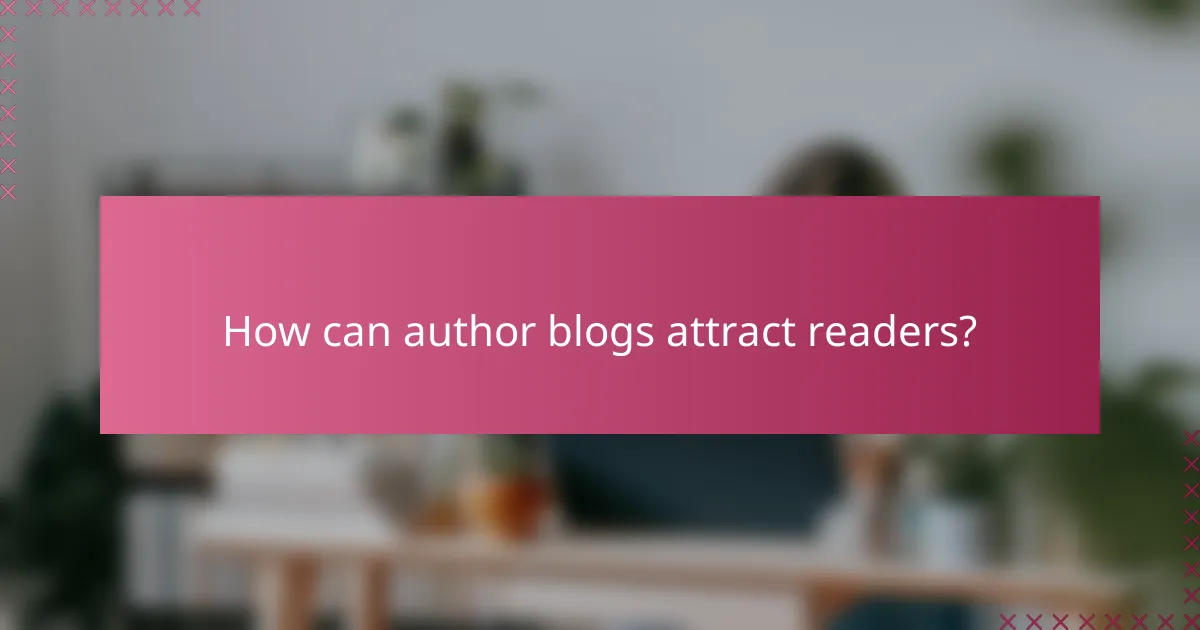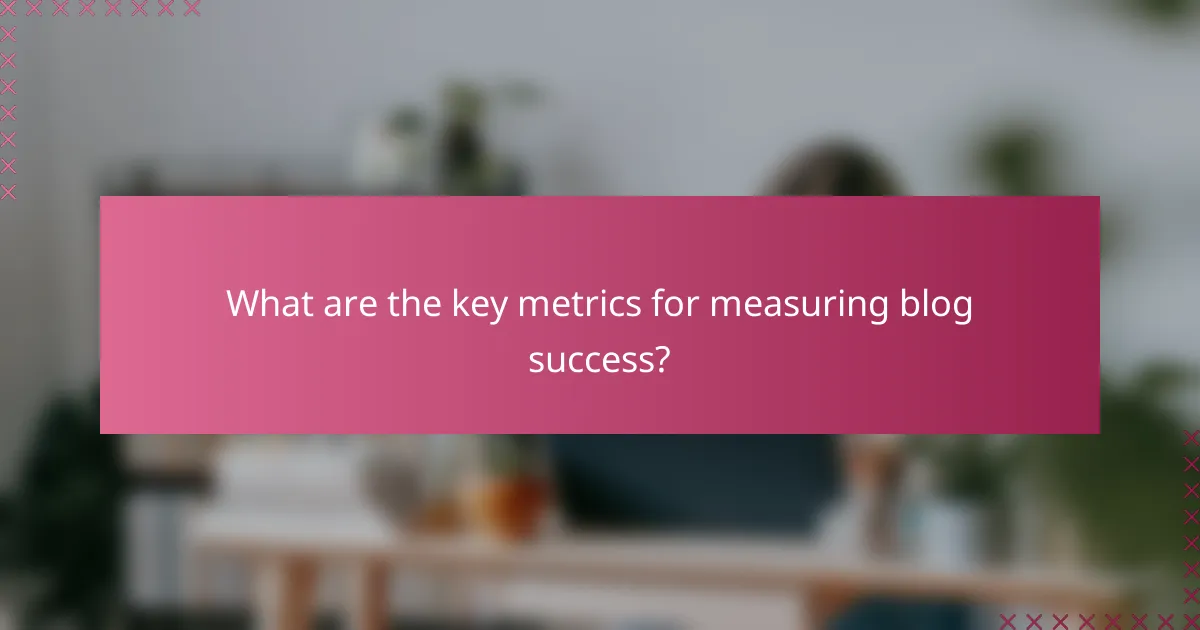Author blogs serve as powerful tools for attracting and engaging readers through compelling content that speaks to their interests. By employing strategies like captivating headlines, appealing visuals, and regular posting schedules, authors can create a loyal audience. Selecting the right platform is also essential, as it impacts how effectively content is delivered and received by readers.

How can author blogs attract readers?
Author blogs can attract readers by creating engaging content that resonates with their target audience. This involves using effective strategies such as captivating headlines, appealing visuals, and strategic promotion on social media platforms.
Engaging headlines
Headlines are the first impression readers have of your blog posts, making them crucial for attracting attention. Use strong, action-oriented words and pose intriguing questions to spark curiosity. For example, instead of “Writing Tips,” consider “Unlock Your Writing Potential with These 5 Essential Tips.”
Keep headlines concise, ideally under 70 characters, to ensure they are fully visible in search results. A/B testing different headlines can also help identify what resonates best with your audience.
Compelling visuals
Visuals enhance the reader’s experience and can significantly increase engagement. Incorporate high-quality images, infographics, and videos that complement your content and break up text to make it more digestible. Tools like Canva can help create professional-looking visuals even without design experience.
Ensure that visuals are relevant to your topic and optimized for fast loading to prevent frustrating delays. Aim for a balance between text and images, as too many visuals can distract from your message.
Targeted social media promotion
Promoting your blog on social media platforms can drive significant traffic. Identify where your target audience spends their time, whether it’s Facebook, Twitter, Instagram, or LinkedIn, and tailor your posts accordingly. Share snippets of your blog content along with engaging visuals to entice clicks.
Utilize hashtags and join relevant groups to expand your reach. Regularly engage with your audience by responding to comments and sharing user-generated content to build a community around your blog.
Email newsletter integration
Integrating an email newsletter is a powerful way to keep readers informed and engaged. Offer a subscription option on your blog to capture email addresses, and provide incentives such as exclusive content or free resources. Regular newsletters can remind subscribers of new posts and encourage them to revisit your blog.
Keep your newsletters concise and visually appealing, with clear calls to action. Aim for a frequency that maintains interest without overwhelming your audience, such as bi-weekly or monthly updates.

What content strategies enhance engagement?
Effective content strategies that enhance engagement include storytelling techniques, interactive content features, and maintaining a regular posting schedule. These approaches help capture reader interest, encourage interaction, and foster a loyal audience.
Storytelling techniques
Storytelling techniques can significantly boost reader engagement by creating emotional connections. Use relatable characters, compelling plots, and vivid imagery to draw readers into your narrative. For instance, sharing personal anecdotes or case studies can make your content more relatable and memorable.
Consider using a clear structure with a beginning, middle, and end to guide your audience through the story. This format helps maintain interest and encourages readers to stay until the conclusion, increasing the likelihood of sharing your content.
Interactive content features
Incorporating interactive content features, such as polls, quizzes, and comment sections, can enhance reader engagement by inviting participation. These elements encourage readers to actively engage with your content rather than passively consuming it. For example, a quiz related to your blog topic can provide personalized insights and keep readers coming back for more.
Additionally, consider using multimedia elements like videos and infographics to make your content more dynamic. These features can cater to different learning styles and keep your audience engaged longer.
Regular posting schedule
Establishing a regular posting schedule is crucial for maintaining reader interest and building a loyal audience. Consistency helps readers know when to expect new content, which can increase return visits. Aim for a frequency that is manageable for you, whether it’s weekly, bi-weekly, or monthly.
To keep your audience engaged, plan your content in advance and create a content calendar. This approach allows you to maintain variety and relevance in your posts, ensuring that you cover diverse topics that interest your readers while avoiding burnout.

Which platforms are best for author blogs?
Choosing the right platform for your author blog is crucial for effective content delivery and reader engagement. Popular options include WordPress, Blogger, and Medium, each offering unique features that cater to different needs and preferences.
WordPress for customization
WordPress is renowned for its extensive customization options, allowing authors to create a blog that reflects their personal brand. With thousands of themes and plugins available, you can tailor the design and functionality to suit your specific requirements.
When using WordPress, consider self-hosting for greater control over your site. This option may involve additional costs, typically ranging from $5 to $30 per month, depending on your hosting provider and the features you choose.
Blogger for simplicity
Blogger is an excellent choice for those seeking a straightforward, user-friendly platform. It requires minimal technical knowledge, making it ideal for new authors who want to focus on writing rather than website management.
While Blogger offers fewer customization options than WordPress, it is free to use and integrates easily with Google services. This can be beneficial for authors looking to leverage tools like Google Analytics for tracking blog performance.
Medium for community engagement
Medium is designed for writers who prioritize community interaction and content discovery. This platform allows authors to reach a broader audience through its built-in readership and social features.
On Medium, your posts can gain visibility through tags and recommendations, which can significantly increase engagement. However, keep in mind that you have limited control over the design and monetization options compared to other platforms.

What are the key metrics for measuring blog success?
Key metrics for measuring blog success include traffic analytics, reader engagement rates, and conversion tracking. These metrics provide insights into how well your blog attracts and retains readers, as well as how effectively it drives desired actions.
Traffic analytics
Traffic analytics involves tracking the number of visitors to your blog and understanding their behavior. Key indicators include page views, unique visitors, and session duration, which help gauge overall interest and reach.
Utilize tools like Google Analytics to monitor these metrics. Aim for consistent growth in traffic over time, and consider seasonal trends that may affect visitor numbers. A good benchmark is to see a steady increase in unique visitors month over month.
Reader engagement rates
Reader engagement rates measure how actively visitors interact with your content. Metrics such as comments, shares, and time spent on a page are crucial indicators of how compelling your content is.
To improve engagement, focus on creating high-quality, relevant content that resonates with your audience. Aiming for a comment-to-traffic ratio of around 1-2% can be a practical target for many blogs.
Conversion tracking
Conversion tracking assesses how well your blog achieves specific goals, such as newsletter sign-ups or product purchases. This metric is vital for understanding the effectiveness of your calls to action and overall content strategy.
Set up conversion goals in your analytics tool to monitor these actions. A conversion rate of 1-5% is typical for many blogs, but this can vary widely based on the niche and audience. Regularly test different strategies to optimize your conversion rates.

How do SEO techniques improve blog visibility?
SEO techniques enhance blog visibility by optimizing content for search engines, making it easier for potential readers to find your posts. By implementing strategies like keyword optimization, crafting effective meta descriptions, and building backlinks, authors can significantly increase their blog’s reach and engagement.
Keyword optimization
Keyword optimization involves researching and selecting relevant terms that potential readers are likely to search for. Incorporating these keywords naturally into your blog posts, including titles, headings, and throughout the content, helps search engines understand the topic of your articles.
To effectively optimize keywords, aim for a mix of short-tail and long-tail keywords. Short-tail keywords are broader and more competitive, while long-tail keywords are more specific and often less competitive, making them easier to rank for. Tools like Google Keyword Planner can assist in identifying valuable keywords.
Meta descriptions
Meta descriptions are brief summaries of your blog posts that appear in search engine results. A compelling meta description can entice users to click on your link, improving your click-through rate. Aim for around 150-160 characters, including your primary keyword to enhance relevance.
When writing meta descriptions, focus on clarity and appeal. Use action-oriented language and highlight what makes your content unique. Avoid duplicating meta descriptions across posts, as unique descriptions can improve your overall SEO performance.
Backlink strategies
Backlink strategies involve acquiring links from other reputable websites to your blog. These links act as endorsements, signaling to search engines that your content is valuable and trustworthy. High-quality backlinks can significantly boost your blog’s authority and visibility.
To build backlinks, consider guest blogging on related sites, collaborating with other authors, or creating shareable content like infographics. Avoid low-quality or spammy links, as they can harm your blog’s reputation and search rankings. Aim for a diverse backlink profile by targeting various sources.
